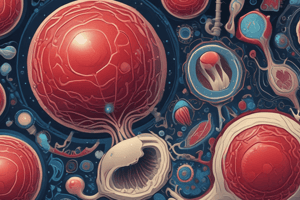Podcast
Questions and Answers
What are the main functions of bones?
What are the main functions of bones?
Protects internal organs, stores and releases lipids, produces blood cells, stores and releases minerals, facilitates movement, and supports the body.
What is the difference between yellow bone marrow and red bone marrow?
What is the difference between yellow bone marrow and red bone marrow?
Yellow bone marrow is mostly fat storage and the Adipocytes contain triglycerides that are used as a form of energy for other tissues. Red bone marrow is responsible for producing red blood cells, white blood cells, and platelets.
What are the main components of bone matrix?
What are the main components of bone matrix?
Bone matrix is composed of ⅓ collagen fibers and ⅔ calcium and phosphate salts.
What are the four main types of bone cells?
What are the four main types of bone cells?
What is Paget's disease and what are some of its symptoms?
What is Paget's disease and what are some of its symptoms?
What are the two main types of bone tissue and their main characteristics?
What are the two main types of bone tissue and their main characteristics?
Which type of bone is most commonly found in the diaphysis (shaft) of a long bone?
Which type of bone is most commonly found in the diaphysis (shaft) of a long bone?
Which of these is NOT a classification of bone?
Which of these is NOT a classification of bone?
What is the difference between an open fracture and a closed fracture?
What is the difference between an open fracture and a closed fracture?
What are the two main types of bone healing and how do they differ?
What are the two main types of bone healing and how do they differ?
Flashcards
Bone Functions
Bone Functions
Bones protect internal organs, store & release minerals, produce blood cells, facilitate movement, and support the body.
Yellow Bone Marrow
Yellow Bone Marrow
A type of bone marrow that stores and releases fat, primarily triglycerides, for energy.
Red Bone Marrow
Red Bone Marrow
Bone marrow involved in the formation of blood cells (RBCs, WBCs, and platelets).
Bone Structure (Long Bone)
Bone Structure (Long Bone)
Signup and view all the flashcards
Epiphysis
Epiphysis
Signup and view all the flashcards
Articular Cartilage
Articular Cartilage
Signup and view all the flashcards
Metaphysis
Metaphysis
Signup and view all the flashcards
Diaphysis
Diaphysis
Signup and view all the flashcards
Periosteum
Periosteum
Signup and view all the flashcards
Medullary Cavity
Medullary Cavity
Signup and view all the flashcards
Bone Classification
Bone Classification
Signup and view all the flashcards
Compact Bone
Compact Bone
Signup and view all the flashcards
Spongy Bone
Spongy Bone
Signup and view all the flashcards
Bone Matrix
Bone Matrix
Signup and view all the flashcards
Osteogenic Cells
Osteogenic Cells
Signup and view all the flashcards
Osteoblasts
Osteoblasts
Signup and view all the flashcards
Osteocyte
Osteocyte
Signup and view all the flashcards
Osteoclast
Osteoclast
Signup and view all the flashcards
Paget's Disease
Paget's Disease
Signup and view all the flashcards
Open Fracture
Open Fracture
Signup and view all the flashcards
Closed Fracture
Closed Fracture
Signup and view all the flashcards
Fracture Reduction
Fracture Reduction
Signup and view all the flashcards
Open Reduction
Open Reduction
Signup and view all the flashcards
Closed Reduction
Closed Reduction
Signup and view all the flashcards
Direct Bone Healing
Direct Bone Healing
Signup and view all the flashcards
Indirect Bone Healing
Indirect Bone Healing
Signup and view all the flashcards
Study Notes
Bone Structure and Function
- Bones protect internal organs like the brain (skull) and spinal cord (vertebral column)
- Bones store and release fats (yellow bone marrow) and minerals (calcium, phosphorus)
- Bones produce blood cells (red bone marrow)
- Bones facilitate movement by providing attachment points for muscles and creating scaffolding for the body
- Bone marrow, a connective tissue, is found inside most bones
- Yellow bone marrow stores fat (adipocytes) and energy (triglycerides)
- Red bone marrow produces blood cells (hematopoiesis) like RBCs (Red Blood Cells), WBCs (White Blood Cells), and platelets.
Bone Marrow
- Yellow bone marrow stores fat for energy.
- Red bone marrow produces blood cells (red blood cells, white blood cells, platelets)
Parts of a Long Bone
- Epiphysis: the end of a long bone, articulates with another bone to form a joint (covered with hyaline cartilage).
- Articular cartilage: covers the epiphysis, allowing smooth joint movement.
- Metaphysis: region where the epiphyseal plate (growth plate) is located
- Diaphysis: the shaft of the long bone
- Periosteum: a tough, vascular covering of tissue
- Medullary cavity: the hollow chamber within the diaphysis (contains bone marrow)
Classification of Bones
- Bones are classified by shape, including long (e.g., femur, humerus), short (e.g., carpals, tarsals), flat (e.g., sternum, ribs), irregular (e.g., vertebrae), and sesamoid (e.g., patella). Each bone type has a specific function related to its shape.
Compact vs. Spongy Bone
- Compact bone: Dense, tightly packed tissue, continuous extracellular matrix. Found in diaphysis of long bones.
- Spongy bone: Irregular thin bony plates (trabeculae), highly developed to resist compressive forces and reduce weight. Found in epiphysis of long bones.
Bone Matrix
- Osseous tissue (bone tissue): connective tissue that supports osteocytes (bone forming cells), providing structure and flexibility.
- The matrix is composed of 1/3rd collagen fibers and 2/3rd calcium and phosphate salt.
- Collagen provides flexibility and framework, while calcium phosphate provides hardness and strength
Bone Cells
- Osteogenic cells: stem cells that differentiate into osteoblasts.
- Osteoblasts: form the bone matrix by secreting collagen that is subsequently mineralized.
- Osteocytes: mature bone cells that maintain bone tissue.
- Osteoclasts: reabsorb (break down) old bone tissue.
Paget's Disease
- Disorder of bone remodeling process
- Patients usually over 40 years old
- Overactive osteoclasts
- Bones are prone to fractures, and symptoms include pain, bone deformities, and frequent fractures
Bone Fractures
- Open fractures: the fractured bone breaks through the skin
- Closed fractures: the fractured bone remains within the skin but out of alignment
- Reduction: manipulating the bone back into alignment
- Open reduction: Requires surgery
- Closed reduction: Does not require surgery
Fracture Repair
- Direct bone healing: osteoblasts and osteoclasts unite broken structures by direct contact, forming new bone
- Indirect bone healing: cartilaginous patches form between broken bones before regeneration begins.
Studying That Suits You
Use AI to generate personalized quizzes and flashcards to suit your learning preferences.




